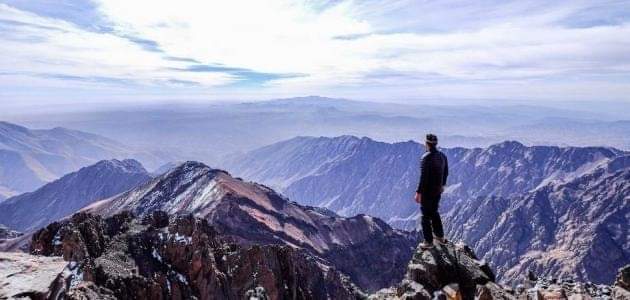High Atlas Hiking: Rugged Peaks and Berber Villages Near Marrakech
Explore the High Atlas Mountains just outside Marrakech, where dramatic peaks meet traditional Berber villages. This hike offers immersive natural beauty and cultural encounters, balanced with practical trail advice to help you prepare for an adventurous, rewarding trek.
Start Early to Beat the Heat
Begin hikes before sunrise in summer to avoid midday heat and enjoy cooler mountain air, reducing risk of dehydration and fatigue.
Hire a Local Guide
Engage a Berber guide for navigation, cultural insight, and support, which enhances safety and enriches your experience.
Footwear Matters
Use sturdy hiking boots with good ankle support and tread to manage rocky, uneven terrain effectively and avoid injury.
Hydrate Frequently
Carry at least 2 liters of water per person and refill at trusted village points; mountain streams may not always be safe to drink without treatment.
High Atlas Hiking: Rugged Peaks and Berber Villages Near Marrakech
The High Atlas Mountains rise with a raw, unyielding presence just a couple of hours’ drive from Marrakech, offering a hiking experience that balances rugged beauty with cultural depth. Trails weave through craggy peaks that stand fiercely against the sky, their shadows stretching over valleys dotted with traditional Berber villages. The terrain varies from pine forests that hum with the whisper of wind and rustling leaves to stony paths that dare you to keep steady footing.
Starting from Imlil, the village that acts as the gateway to the High Atlas, hikers can plan routes ranging from moderate day hikes to multi-day treks. Typical trails span 8 to 15 kilometers with elevation gains of 600 to 1000 meters, demanding a solid but accessible physical effort. Along the way, the mountain air carries the scent of cedar and herbs, while rivers flowing down sharp valleys push forward with a cool persistence.
Following these paths, you’ll encounter small Berber villages built from sun-dried clay, their flat roofs and winding alleys telling stories of a life tied closely to the mountain rhythms. Engaging with local guides not only enriches your understanding of this landscape but also supports communities that maintain these trails.
Timing your hike is important: spring and fall offer comfortable temperatures and blooming wildflowers or fiery autumn hues, while summer climbs bring stronger sunlight but cooler high-altitude breezes. Winter routes require more preparation due to snow and ice.
Practical considerations include sturdy hiking boots with good ankle support and waterproofing, layered clothing adaptable to shifting temperatures, and plenty of water—streams can be unpredictable. The trail’s challenges hinge on sudden weather changes and uneven paths, so remain alert and respect the mountain’s fierce independence.
Whether you’re taking in the panoramic views of jagged peaks or pausing to watch shepherds tend their flocks amidst golden fields, the High Atlas demands a dynamic, respectful engagement. This isn’t simply a walk outdoors—it’s a negotiation with a landscape fiercely itself, offering tangible rewards for those ready to meet it on its terms.
Nearby Trips
All Adventures
Boat Charters
Water Activities
Adventures near Marrakech
Discover the unique and memorable adventures that make Marrakech special.
Frequently Asked Questions
How physically demanding is hiking in the High Atlas Mountains?
Most hikes in the High Atlas involve moderate elevation gains between 600 and 1000 meters with steep, uneven trails. A reasonable fitness level is needed, but no advanced mountaineering skills are required for common routes.
Do I need a guide to hike in the High Atlas?
While not legally required on all trails, hiring a local Berber guide is highly recommended for safety, navigation, and cultural insight. Guides can also facilitate village visits and offer support in emergencies.
What’s the best time of year to hike in the High Atlas?
Spring and fall offer the best balance of mild weather and stable trail conditions. Summer is hot in lower elevations but manageable with early starts. Winter entails snow and requires extra caution and equipment.
Are there potable water sources on the trail?
Some villages provide safe potable water, but natural streams should be treated or filtered to avoid contamination. It's best to carry sufficient water and plan refills carefully.
How culturally accessible are the Berber villages along the trails?
Many villages welcome visitors and offer homestays or refreshments. Engaging respectfully with locals can enrich your hike and support the community economically.
What wildlife might I encounter while hiking here?
Expect to see Barbary sheep, various bird species like the bearded vulture, and smaller mammals. Wildlife tends to be shy but observant hikers can get rewarding glimpses.
Recommended Gear
Sturdy Hiking Boots
Provides ankle support and traction on rocky, uneven trails.
Layered Clothing
Allows you to adapt quickly to shifting temperatures—from warm sun to chilly mountain wind.
Hydration System
To carry enough water and permit easy access during long, exposed sections.
Light Trekking Poles
Helpful for balance on ice, stream crossings, or descending steep rocky sections.
Local Insights
Hidden Gems
- "Aroumd village offers quieter trails with stunning views of Mount Toubkal’s western face."
- "The Valley of Ourika, with expansive cascades, is less crowded and rich in birdlife."
Wildlife
- "Barbary macaques in forested areas along the trail edges."
- "Golden eagles and bearded vultures soaring above high ridges."
History
"The High Atlas is home to Berber tribes who have lived in this challenging environment for centuries, maintaining traditional farming and herding methods. Trails once served as critical trade and communication routes."

